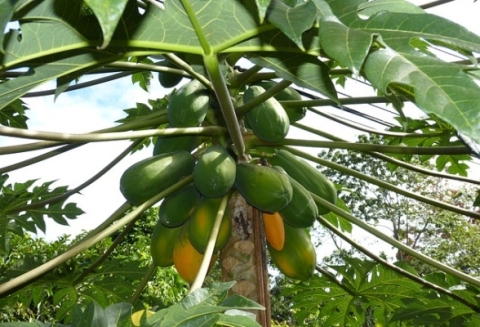The Pawpaw Wars
When I was about five years old, my parents decided it was time to move. At the time we were living in an old and rather musty two storey rented house at number 10 Langdon Road in the suburb of Kumalo, Bulawayo, Southern Rhodesia.
We moved to a brand new one story home which they had bought at 34 Chaplin Road. It was just a ten-minute bicycle ride away but even at that young age I sensed that it meant a whole lot more to my parents than an improvement in living conditions. It was symbolic of their newly acquired status as respected members of the Bulawayo Jewish community and a tribute to their determination to make a good life for me and my infant brother in the shadow of the holocaust.
The house came with bare white walls which over the years slowly filled with art, some of it painted by my mum, and some at a later stage by me.
The far bigger challenge was the bare, unplanted garden of around one acre. It was there that my mother triumphed most spectacularly and where our love affair with the pawpaw began.
My parents grew up in pre-world war two Lithuania where they were more familiar with wild berries, cherry trees, pears and apple blossom. I will never know what made my mother decide to plant that most exotic and curious of trees, the pawpaw.
There it stood on a patch of garden just beyond the terrace where we often sat or would sometimes dine under a canopy of bougainvillea. It started small and for some years did very little despite our daily efforts to encourage its growth. It was purely decorative, in many ways resembling those wonderful indoor Swiss Cheese plants which became all the rage in the 1970s and which can still be found in flower shops in Tel Aviv today.
Did my mother realise that pawpaws were such a weird form of plant life when she went out and bought our little tree? I suspect not. These days pawpaws of the small, avocado shaped Far Eastern variety are widely available in supermarkets but the large, melon shaped ones are still a rarity, as my efforts to locate one in Tel Aviv have revealed. And that is because it takes an almost miraculous combination of circumstances to get a tree to produce fruit.
The pawpaw comes in distinct male and female species: the female produces the fruit and the male the flowers which pollinate them, but it is impossible to know which is which until they reach maturity which can take as much as ten years. The trees grow independently but need to be sufficiently close for pollination to occur. The chances of having a female tree in a large Bulawayo garden with a male version within striking distance must surely have been close to zero.
To complicate matters, it seems that bees, the traditional and most efficient of pollinators, are just not interested, or to be more precise, are put off by the vaguely putrid smell which the flowers produce. Pollination thus relies on the slow and cumbersome activities of flies and beetles who apparently mistake the red flowers of the male for decaying meat.
It took five years for our little tree to eventually disclose its identity and reward our patience with a prolific crop of huge, orange fleshed, divine tasting fruit, fruit which Christopher Columbus described as the "fruit of angels" when he first tasted it on reaching the Americas.
In its original, tropical habitat in the West Indies, the pawpaw, or papaya, grows in groves where both female and male species abound, allowing cross pollination to occur. Modern cultivators, mostly in India and the Far East, sidestep the problem of fertilisation by growing the trees from grafts. Back in Bulawayo in the 1950s neither of these options were available.
So it was something of a miracle that our little tree eventually bore fruit which would arrive at the table in a large glass bowl, in small, ball shaped scoops, sprinkled with lemon juice and chilled in the fridge.
Where, though, was the mystery male who had pollinated our lone tree? We finally traced it to the garden of our less fortunate neighbors, the Loewensteins, who moved in at around the same time as we did and had been similarly inspired to plant a pawpaw tree. Theirs had turned out to be the male which our tree needed in order to produce its fruit but which would never produce fruit of its own.
I can still see the look of mischievous glee on my mother's face as she savoured the discovery. And I can also see the look of somewhat grudging gratitude on the face of our neighbors when she offered to share our bonanza with them. In the great lottery of the pawpaw trees, my parents had won out. Our neighbours knew it, as did all of Bulawayo. But I am happy to report that they did not begrudge my parents their symbolic moment of good fortune and remained not just good neighbors, but great friends.








Comments